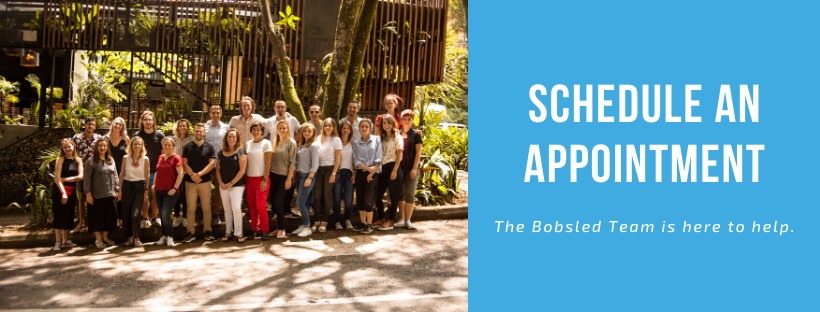✍ This article was written by Bobsled Marketing Manager Tom Crosthwaite
with contributions from Bobsled PPC Manager Ross Walker.
Brand awareness is a general and somewhat murky term. Ultimately, every measure of brand awareness leads in some way back to market share ownership - how much of the total pie Brand X is “winning” in relation to direct competitors selling within the same niche.
Back in the brick-and-mortar days, gauging brand awareness was perhaps a little more straightforward. But due to the rapid ascension of ecommerce, and specifically online marketplaces like Amazon, figuring out the most relevant digital yardsticks and correct growth strategy has become an incredibly complex task for a lot of brands.
It’s the start of a new decade, and many digital marketers are currently asking the same question; what should our 2020 brand awareness goals be and what’s the right strategy to ensure we smash all of our target metrics?
 In this article, Bobsled PPC Manager Ross Walker discusses how to align Amazon PPC spend ROI with overall brand goals, and how to leverage DSP for greater creative control.
In this article, Bobsled PPC Manager Ross Walker discusses how to align Amazon PPC spend ROI with overall brand goals, and how to leverage DSP for greater creative control.
In addition to general best practices, we’ve included some advertising and DSP processes/checklists that we use here at Bobsled.
So if growing brand awareness was one of your New Year's resolutions, then this blog post is tailor-made for you!
Bobsled PPC Manager Ross Walker
The 4 Phases
The first step is to accurately assess your current position within the marketplace.
“Broadly speaking, a brand selling on Amazon can be in one of four different phases; launch, growth, steady state or decline,” Ross explains.
According to Ross, these barriers are highly fluid.
“More often than not, certain sub-sections within an account will be performing differently,” he says. “For example, a brand may have a flagship product line that is in the growth phase, and some new products that are very much still in the launch phase. However, to assess overall awareness, it’s worthwhile to accurately aggregate all the moving parts in order to gain a macro understanding of your brand’s positioning.”
What Should My ROI Goals Look Like?
Your self-assessed phase should directly influence your advertising goals in respect to ad spend ROI.
- Launch - flat or negative ROI to facilitate early clicks, establish sales history and start generating data. Consider this your “pay to play” period.
- Growth - break-even ROI to keep the pressure on and take advantage of your incrementally increasing sales velocity that the Amazon algorithm loves to reward.
- Steady State - positive ROI to generate profits from a stable base of sales.
- Decline - flat or negative ROI as a means to start challenging your competitors once again. Consider this your “pay to get back in the game” period.
The OODA Loop
Once you’ve identified your position, the next step is to develop a plan of attack. “At Bobsled, we use something called an OODA Loop,” Ross explains. “It’s a multi-application process that helps us continually refine our PPC strategies.”
The OODA Loop process is outlined below.
- O - Observe. Where is your brand, catalog of products or individual SKU in terms of advertising spend, sales, ACoS and conversion rate percentage? To quote Peter Drucker, “what gets measured, gets managed.” Before any changes are implemented, ensure all core metrics are getting tracked to establish a clear baseline.
- O - Orient. Consider what you learned while observing, juxtaposed against your product’s competitiveness on Amazon. Utilize a share of voice analysis to see how your efforts are actually playing out in search results. Look closely at your most direct competitors, and see if your best performing campaigns are really giving you the position you want.
- D - Decide. The orientation step will help you determine whether your current strategy is satisfactory, or whether minor/major tweaks are necessary. Once a decision has been made, develop an action plan.
- A - Act. Implement changes, and start the loop again to see if you got the results you wanted.
The OODA approach can benefit brands no matter what situation they find themselves in.
“What I love about the OODA Loop is that you can manipulate the timeline however you see fit,” Ross explains. “When I take ownership of an advertising account that’s been severely neglected and is well and truly in decline, I may run a brief two-week OODA Loop to steady the ship to gain some quick wins. And when the loop starts again, I’ll methodically push the timeline out. The ultimate goal is to be in a position where we can plan each financial quarter out well in advance.”
What Other Levers Can I Pull?
All of the above strategies help build brand awareness through the use of PPC advertising within the Amazon ecosystem.
“It’s no secret that there’s a ton of traffic on Amazon,” Ross explains. “But at the same time, competition is fierce. So generating brand awareness can be a really long haul, even if your PPC strategy is really dialed in.”
Brands looking for another lever may want to consider Amazon DSP.
“Internal traffic has its limitations, and certain brands could certainly hit a point of diminishing returns when it comes to super aggressive PPC spend,” Ross explains. “Brands in this position should certainly consider Amazon DSP as a way to complement their existing PPC activity.”
Interested in an outside perspective about your PPC performance? Get a free, no obligations Amazon Advertising audit from Bobsled Marketing’s PPC experts with 10M+ Amazon Advertising dollars managed in their portfolio!
Learn More
What Is Amazon DSP?
Amazon Demand-Side Platform (DSP) is a Display Advertising Platform that allows brands to programmatically reach relevant audiences on Amazon sites and apps as well as publishing partners on third-party exchanges.
Amazon has the largest database of online shoppers in all stages of the customer journey across hundreds of retail categories. Brands can drive valuable top-of-funnel awareness through lookalike, lifestyle, in-market, retargeting and remarketing audiences using various methods of retargeting and data collection.

Above: The Amazon DSP Brand Awareness Funnel
For those interested in learning more, take a read of our blog post Amazon DSP 101: Beginners Guide To Understanding Amazon’s Demand-Side Platform.
Amazon DSP Do’s & Don'ts
For those with a purely PPC background, getting started with DSP can be very daunting. Here are some general best practices.
The Do’s
- Look at all the brand level insights (behavioral, contextual, and demographic) Amazon provides to get a true sense of what your audience looks like. If you choose to ignore useful audience data, this will likely hurt your bottom line.
- Talk with your Amazon DSP rep and get their feedback on your strategy. Yes, they want you to spend more on advertising with their platform. But they also have a vested interest in seeing you hit your brand awareness goals over the long-term.
- Lean heavily on lookalike audiences. This involves supplying Amazon with all your relevant in-house audience data. Amazon will then create “hashed” audiences, which involves blocking out all the personal info data from your internal audience and customer list/s, in order to create a lookalike profile you can target with DSP. Again, this is all about leveraging huge amounts of useful audience data to get highly specific with your DSP strategy.
- Manage your ROI expectations, and don’t expect DSP results to mirror Amazon PPC performance. By definition, DSP is more top-of-funnel.
The Don’ts
- Even if you’re a PPC heavy-hitter, don’t feel compelled to start your DSP journey with a spend level that rivals your Amazon Advertising budget. At the time of publication, Amazon’s minimum DSP spend requirement is $10k/month - we’d recommend starting moderately, and ramping up as you get more insight with DSP analytics.
- Remember that you’re entering a unique platform, and simply reusing creative that worked somewhere else may not be the best move. Custom creative for DSP is highly recommended.
- There may be exceptions, but if you have a very low priced product line, it’s unlikely that your profit margin will allow you to spend speculatively with DSP.
- If you don’t have a holistic brand strategy in place, hold off on starting with DSP. Having a general roadmap will make forming an effective DSP strategy a whole lot easier.
[FREE RESOURCE] THE AMAZON DSP CHECKLIST
Grow Brand Awareness Now

This free PDF will give you a thorough explanation of Amazon DSP and how to align it strategically with your brand goals. And in addition to our DSP checklist & best practices, we’ve also included a DSP case study from one of our clients here at Bobsled.
DSP Management Timeline Checklist
Ready to take the plunge into DSP land? The following management timeline checklist will help you with your launch and initial performance tracking.
1. Set up - establish KPI, set up advertiser, order, line levels
- Purchase vs awareness/reach
- (ROAS/CPP)
vs
-
- Detail page view rate (DPVR)
- Click through rate (CTR)
- Viewability goal
- Video completion rate (VCR)
- Brand lift (via Nielsen DBE study)
2. Review -
- Campaign budget
- Line item setup
- Flight dates
- Pixel association
- ASIN association
- Optimization - Leverage automatic optimization,
- Use manual optimization levers
- Report - dashboard and reports
3. Pre optimization checklist
- Confirm the campaign's goal and KPI.
- Check ASINs associated with the order (for brands that sell on Amazon).
- Check that the correct pixels are associated with the order.
- Confirm that budget allocation is correct.
- Confirm campaign flight times.
- Check that line items are correct.
- Check that accurate audience segments are selected.
- Check if creative assets are correct.
4. Wait until at least 30% of campaign period has expired before making optimizations
5. Variables that can affect performance
- Prime day
- Black friday
- Out-of-stock issues
- Poor customer reviews
- Holidays
- Weather conditions
Is 2020 Your Year?
Brands in your niche are likely already harnessing the power of Amazon Advertising & DSP to connect with more customers. Do you need help locking down your gameplan? If so, please schedule an appointment to discuss your situation with the Bobsled team.
Keywords: Amazon PPC, Amazon Strategy, Amazon Advertising, Amazon Consultants, PPC, Amazon DSP, Ross Walker, Amazon Agency, Tom Crosthwaite, Brand Awareness, PPC Manager



